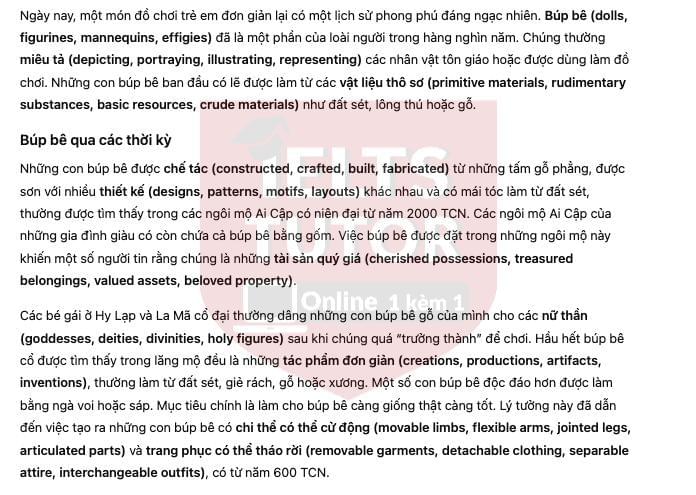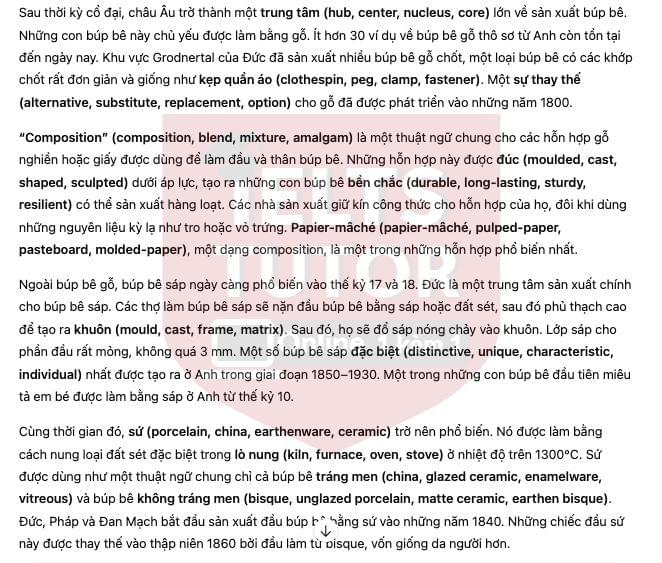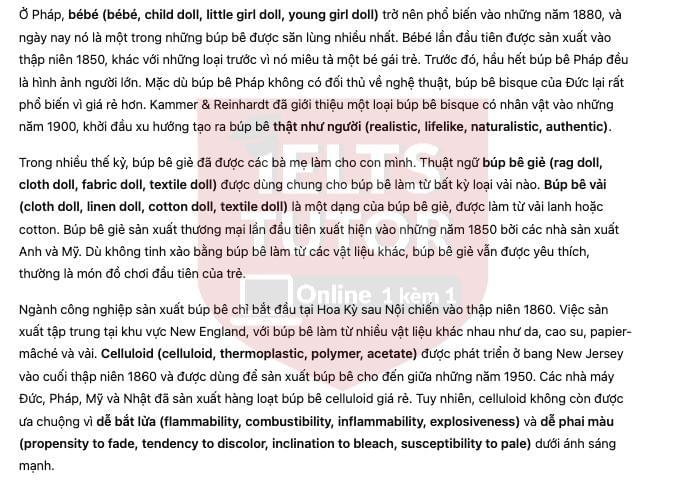IELTS TUTOR cung cấp Dolls through the ages: Đề thi thật IELTS READING (IELTS Reading Recent Actual Test) - Làm bài online format computer-based, , kèm đáp án, dịch & giải thích từ vựng - cấu trúc ngữ pháp khó & GIẢI ĐÁP ÁN VỚI LOCATION
I. Kiến thức liên quan
II. Làm bài online (kéo xuống cuối bài blog để xem giải thích từ vựng & cấu trúc cụ thể hơn)
📩 MN AI CHƯA CÓ ĐÁP ÁN FORECAST QUÝ MỚI PART 1-2-3 NHẮN ZL 0905834420 IELTS TUTOR GỬI FREE HẾT NHA
III. Dolls through the ages: Đề thi thật IELTS READING (IELTS Reading Recent Actual Test)
Reading Passage
What is today a simple children's toy has a surprisingly rich history. Dolls have been a part of humankind for thousands of years. Often depicting religious figures, or used as playthings, early dolls were probably made from primitive materials such as clay, fur, or wood. Dolls through the ages
Dolls constructed of flat pieces of wood, painted with various designs, and with hair made of clay, have often been found in Egyptian graves dating back to 2000 BC. Egyptian tombs of wealthy families have included pottery dolls. Dolls being placed in these graves leads some to believe that they were cherished possessions.
Girls from ancient Greece and Rome offered their wooden dolls to goddesses after they were too 'grown-up' to play with dolls. Most ancient dolls that were found in tombs were very simple creations, often made from such materials as clay, rags, wood, or bone. Some of the more unique dolls were made with ivory or wax. The main goal was to make the doll as lifelike as possible. That ideal led to the creation of dolls with movable limbs and removable garments, dating back to 600 BC.
Following the era of the ancient dolls, Europe became a major hub for doll production. These dolls were primarily made of wood. Fewer than 30 examples of primitive wooden stump dolls from England survive today. The Grodnertal area of Germany produced many peg wooden dolls, a type of doll that has very simple peg joints and resembles a clothespin (a device for hanging washing on a clothesline). An alternative to wood was developed in the 1800s.
'Composition' is a collective term for mixtures of pulped wood or paper that were used to make doll heads and bodies. These mixtures were moulded under pressure, creating a durable doll that could be mass produced. Manufacturers closely guarded the recipes for their mixtures, sometimes using strange ingredients like ash or eggshells. Papier-mâché, a type of composition, was one of the most popular mixtures.
In addition to wooden dolls, wax dolls grew in popularity in the 17th and 18th centuries. Much in Germany was a major manufacturing center for wax dolls. Wax dollmakers would model a doll's head in wax or clay, and then cover it with plaster to create a mould. Then they would pour melted wax into the cast. The wax for the head would be very thin, no more than 3 mm. Some of the most distinctive wax dolls were created in England between 1850 and 1930. One of the first dolls that portrayed a baby was made in England from wax at the basinsion of the 10th centur>> Form đăng kí giải đề thi thật IELTS 4 kĩ năng kèm bài giải bộ đề 100 đề PART 2 IELTS SPEAKING quý đang thi (update hàng tuần) từ IELTS TUTOR
Around the same time porcelain became popular. It is made by firing special clays in a kiln at more than 2372 degrees Fahrenheit (1300°C), and only a few clays can withstand firing at such high temperatures. Porcelain is used generically to refer to both china and bisque dolls; china is glazed, whereas bisque is unglazed. Germany, France, and Denmark started creating china heads for dolls in the 1840s. These china heads were replaced in the 1860s by ones made of bisque. Bisque, which is porcelain fired twice with colour added to it after the first firing, looked more like skin than china did.
In France, the bébé was popular in the 1880s, and it has become a highly sought after doll today. The bébé, first made in the 1850s, was different from its predecessors because it depicted a younger girl. Until then, most French dolls were representations of adults. Although the French dolls were unrivalled in their artistry, German bisque dolls became quite popular because they were not as expensive. Kammer & Reinhardt introduced a bisque character doll in the 1900s, starting a trend of creating realistic dolls.
For many centuries, rag dolls were made by mothers for their children. The term 'rag doll' refers generically to dolls made of any fabric. 'Cloth doll' refers to a subset of rag dolls made of linen or cotton. Commercially produced rag dolls were first introduced in the 1850s by English and American manufacturers. Although not as sophisticated as dolls made from other materials, rag dolls were well loved, often as a child's first toy.
Dollmaking did not become an industry in the United States until after the Civil War in the 1860s. Doll production was concentrated in the New England region of the United States, with dolls made from a variety of materials such as leather, rubber, papier-mâché, and cloth. Celluloid was developed in the state of New Jersey in the late 1860s and was used to manufacture dolls until the mid-1950s. German, French, American, and Japanese factories churned out cheaply produced celluloid dolls in mass quantities. However, celluloid fell out of favour because of its extreme flammability and propensity to fade in bright light.
After World War I, doll makers experimented with plastics. Hard plastic dolls were manufactured in the 1940s. They resembled composition dolls, but they were much more durable. Other materials used in doll manufacturing included rubber, foam rubber, and vinyl in the 1950s and 1960s. Vinyl changed doll making, allowing doll makers to root hair into the head, rather than using wigs or painting the hair. Although most dolls are now mass-manufactured using these modern materials, many modern doll makers are still using the
Questions
Questions 1–6
Complete the notes below.
Choose ONE WORD ONLY for each answer.
Dolls
Earliest known dolls
represented religious figures
used as toys
Egypt 2000 BC
bodies were made of 1.....................
2..................... was used for the hair
Ancient Greece and Rome
dolls were given to 3..................... by older girls
600 BC
realistic dolls had separate clothes and 4..................... that could be put in different positions>> IELTS TUTOR gợi ý tham khảo CẦN VIẾT & THU ÂM BAO NHIÊU BÀI ĐỂ ĐẠT 8.0 SPEAKING & 7.0 WRITING?
17th and 18th centuries
dolls made of 5.....................
moulds made of 6.....................
1800s
.................... became more common
new manufacturing process developed
new group of mixtures known as .....................
recipes for these mixtures kept secret
Questions 7–13
Do the following statements agree with the text?
Write
TRUE - if it agrees;
FALSE - if it contradicts;
NOT GIVEN - if there's no info
7 Bisque dolls appear less realistic than dolls made of china.
TRUE
FALSE
NOT GIVEN
8 French dolls tended to cost more than German bisque dolls.
TRUE
FALSE
NOT GIVEN
9 The first rag dolls were made in the 1850s.
TRUE
FALSE
NOT GIVEN
10 Only dolls made of cotton or linen are classified as cloth dolls.
TRUE
FALSE
NOT GIVEN
11 Dolls made of celluloid tended to lose their colour.
TRUE
FALSE
NOT GIVEN
12 Composition dolls lasted longer than the plastic dolls that were made in the 1940s.
TRUE
FALSE
NOT GIVEN
13 Doll collectors prefer a doll to be dressed in its original clothing.
TRUE
FALSE
NOT GIVEN
IV. Dịch bài đọc Dolls through the ages




V. Giải thích từ vựng Dolls through the ages




VI. Giải thích cấu trúc ngữ pháp khó Dolls through the ages


VII. Đáp án Dolls through the ages


clay
clay
goddesses
limbs
wax
plaster
FALSE
TRUE
FALSE
TRUE
TRUE
FALSE
NOT GIVEN
📩 MN AI CHƯA CÓ ĐÁP ÁN FORECAST QUÝ MỚI PART 1-2-3 NHẮN ZL 0905834420 IELTS TUTOR GỬI FREE HẾT NHA

Các khóa học IELTS online 1 kèm 1 - 100% cam kết đạt target 6.0 - 7.0 - 8.0 - Đảm bảo đầu ra - Thi không đạt, học lại FREE
>> Thành tích học sinh IELTS TUTOR với hàng ngàn feedback được cập nhật hàng ngày



